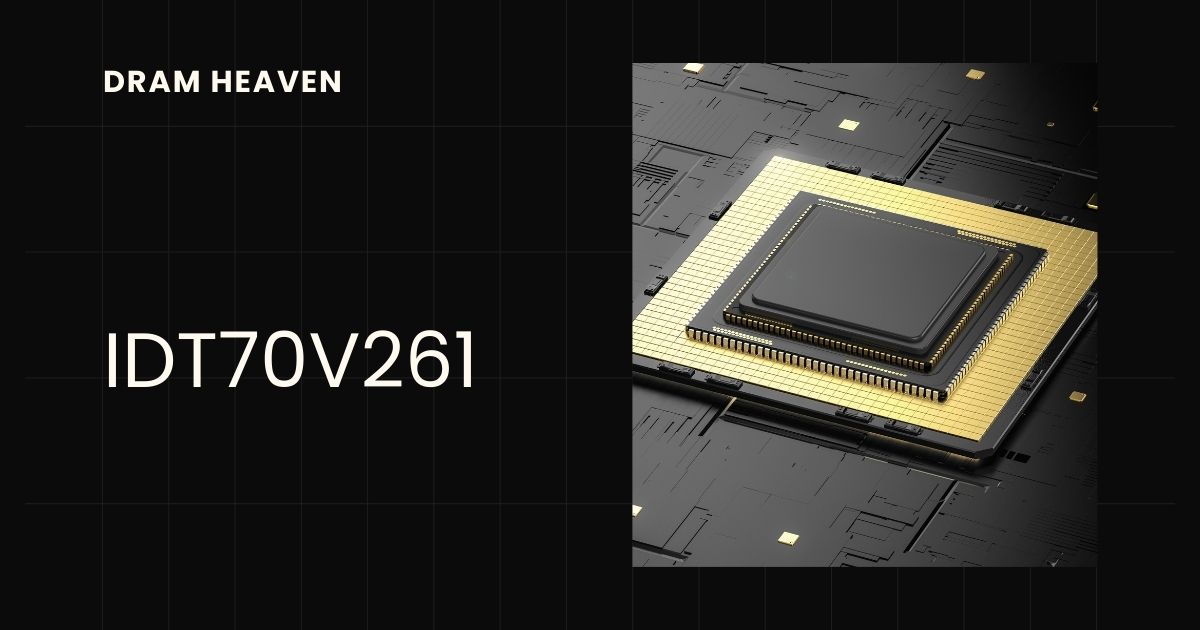The IDT70V261 is a well-regarded component in the realm of digital electronics, particularly in the areas of embedded systems and communication infrastructure. It is a high-speed, low-power dual-port memory, developed by Integrated Device Technology (IDT). Dual-port RAMs like the IDT70V261 are essential for applications that require simultaneous access to a shared memory resource by two independent systems. In this article, we will dive into the specifications, applications, advantages, and unique features of the IDT70V261, making it a preferred choice for designers and engineers worldwide.
What is the IDT70V261?
The IDT70V261 is a high-performance 8K x 16-bit dual-port SRAM (Static Random-Access Memory) that allows two devices to access the memory simultaneously. Unlike standard single-port memory, which only supports one data access at a time, dual-port memory provides an efficient way to handle multi-processor communication, data buffering, and real-time processing tasks.
Key Specifications of the IDT70V261
Memory Size and Organization
The IDT70V261 features a memory size of 8,192 words by 16 bits. This structure allows for the storage of sizable chunks of data while maintaining quick access times. The dual-port capability is a standout feature, enabling data to be read from and written to the memory independently by two separate systems.
High-Speed Access Time
One of the notable characteristics of the IDT70V261 is its fast access time. The memory’s speed is crucial for applications that require rapid data processing. It has access times as low as 15 nanoseconds, making it ideal for high-speed operations in communication systems and real-time applications.
Low Power Consumption
The IDT70V261 is designed with efficiency in mind, offering low power consumption. This is particularly advantageous for embedded systems, where minimizing power usage is critical to ensure longer operational life and energy efficiency.
Simultaneous Read/Write Capability
The dual-port nature of the IDT70V261 allows simultaneous read and write operations. Each port has its own separate address, data, and control lines, allowing independent access without interference, making it suitable for systems where data must be shared between processors or devices without latency.
Features of the IDT70V261
Asynchronous Operation
The IDT70V261 supports asynchronous operation, meaning each port can operate independently with its own clock settings. This makes it flexible for integration into various systems with differing timing requirements, providing versatility in system design.
Built-in Arbitration Logic
To handle potential conflicts when both ports attempt to access the same memory location, the IDT70V261 includes an internal arbitration logic. This feature ensures data integrity and reliable communication between the two ports without requiring additional external logic circuits.
Interrupt Capability
The IDT70V261 comes with interrupt generation capabilities, which allow the memory to signal when specific conditions are met, such as when data is written or read from a particular location. This feature is useful in event-driven systems, where specific actions need to trigger upon memory access.
Applications of the IDT70V261
Embedded Systems
In embedded systems, the IDT70V261 is often used to facilitate communication between a microcontroller and another processing unit. Its dual-port capabilities ensure that two processors can access shared data seamlessly, making it ideal for automotive, industrial control, and IoT applications.
Networking and Communication
The IDT70V261 is widely used in networking hardware, where fast and reliable data transfer between devices is crucial. In routers, switches, and other communication equipment, dual-port RAMs like the IDT70V261 manage data buffers and routing tables efficiently, enhancing overall network performance.
Real-Time Processing
For applications that require real-time processing, such as audio and video processing systems, the IDT70V261’s fast access times and ability to handle simultaneous data operations make it a preferred choice. It ensures that data can be processed and transmitted without lag, which is essential for maintaining quality in multimedia applications.
Advantages of Using the IDT70V261
Enhanced Data Throughput
One of the primary advantages of the IDT70V261 is its ability to enhance data throughput. With the ability to handle simultaneous read and write operations, data can be processed faster, leading to improved system efficiency.
Reduced Latency in Communication
By enabling two devices to communicate directly through a shared memory, the IDT70V261 significantly reduces latency, a crucial factor in high-speed data processing and real-time systems. This feature is beneficial in minimizing communication delays between components.
Increased Flexibility in System Design
The IDT70V261’s dual-port architecture provides increased flexibility in system design. Engineers can build more complex systems without worrying about memory access conflicts, making it easier to develop multi-processor or multi-controller setups.
Comparing the IDT70V261 to Other Dual-Port Memories
IDT70V261 vs. IDT70V257
The IDT70V257 is another dual-port memory from IDT, but it differs in terms of memory size and access speed. While the IDT70V261 offers 8K x 16-bit memory, the IDT70V257 has a smaller capacity but slightly faster access times. Choosing between them depends on the specific requirements of the project, such as memory size versus speed.
IDT70V261 vs. Cypress CY7C1356C
The Cypress CY7C1356C is another popular dual-port memory in the market, known for its high-speed operation. However, the IDT70V261’s combination of low power consumption, built-in arbitration, and interrupt capabilities often makes it a more versatile choice for embedded and networking applications.
Best Practices for Using the IDT70V261
Optimizing for Low Power Consumption
To make the most of the IDT70V261’s low power features, it’s essential to use proper power management techniques, such as placing the memory in low-power standby mode when not in use. This is particularly important in battery-operated and energy-sensitive applications.
Handling Memory Conflicts
Although the IDT70V261 has built-in arbitration logic, developers should still design systems with clear protocols for memory access. Utilizing semaphores or flags can help manage access and prevent data conflicts, ensuring reliable operation.
Choosing the Right Operating Frequency
Selecting the appropriate operating frequency is crucial for balancing speed and power consumption. Operating the IDT70V261 within the recommended frequency ranges ensures optimal performance without unnecessary power drain.
Troubleshooting Common Issues with the IDT70V261
Memory Access Conflicts
In some cases, simultaneous access to the same memory location can lead to conflicts. If conflicts occur, ensure that the system’s protocols for handling access are correctly implemented and that the arbitration logic is functioning as intended.
Power Consumption Concerns
If power consumption is higher than expected, check if the memory is operating in standby mode when idle. Additionally, confirm that the operating frequency is set within the optimal range to prevent unnecessary power draw.
Data Corruption Issues
Data corruption can occur if there is improper handling of read/write operations. Verifying that timing constraints are met and checking for proper interrupt handling can help prevent data-related issues.
Conclusion
The IDT70V261 is a powerful and efficient dual-port memory solution, offering high-speed, low-power operation with features that make it ideal for a wide range of applications Its ability to handle simultaneous access, along with built-in arbitration and interrupt capabilities, makes it a versatile choice for complex systems that require reliable and fast communication between processors Whether used in networking equipment, embedded systems, or real-time processing applications, the IDT70V261 continues to be a dependable choice for engineers and designers.
FAQs
- What is the IDT70V261 used for?
It is used for highspeed data processing in embedded systems, networking equipment, and real-time applications where simultaneous memory access is crucial. - How does dual-port RAM like the IDT70V261 work?
It allows two devices to access the same memory simultaneously, with separate address, data, and control lines for each port, enabling efficient communication without delays. - What are the key features of the IDT70V261?
The IDT70V261 includes asynchronous operation, low power consumption, built-in arbitration logic, and interrupt capabilities for event-driven systems. - What is the access time of the IDT70V261?
The IDT70V261 offers fast access times as low as 15 nanoseconds, making it suitable for high-speed applications. - How can memory conflicts be managed with the IDT70V261?
Built in arbitration logic handles conflicts, but additional measures like semaphores or flags can be used to ensure smooth and reliable memory access.


[…] are a cornerstone of medical practice, reflecting both the history and advancements in healthcare. From surgical precision to emergency care, these tools exemplify the importance of […]
[…] the WowzaGradle Plugin offers numerous advantages. It automates repetitive tasks, reduces human errors, and optimizes development cycles. Additionally, it integrates seamlessly […]